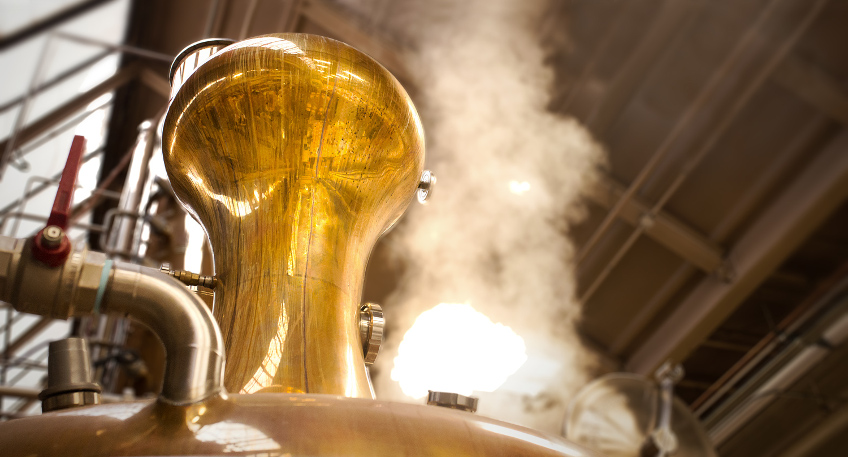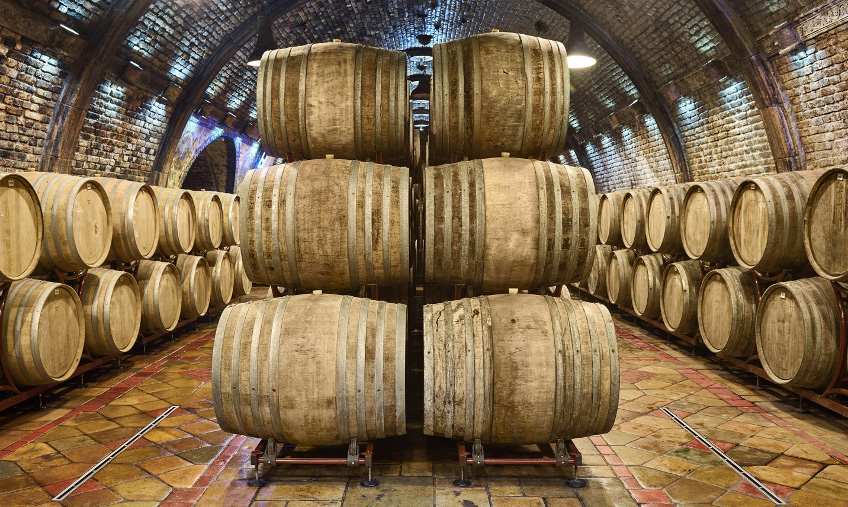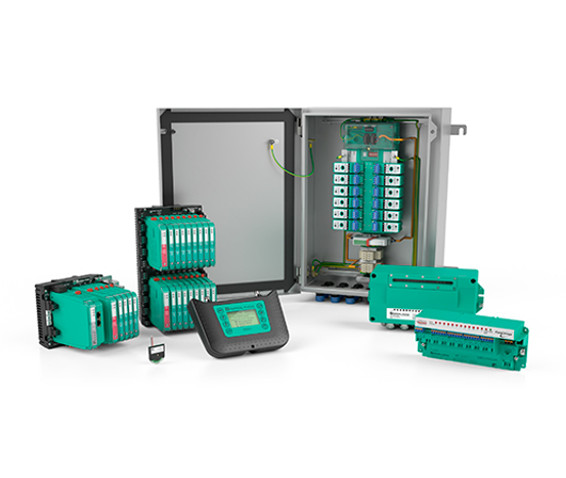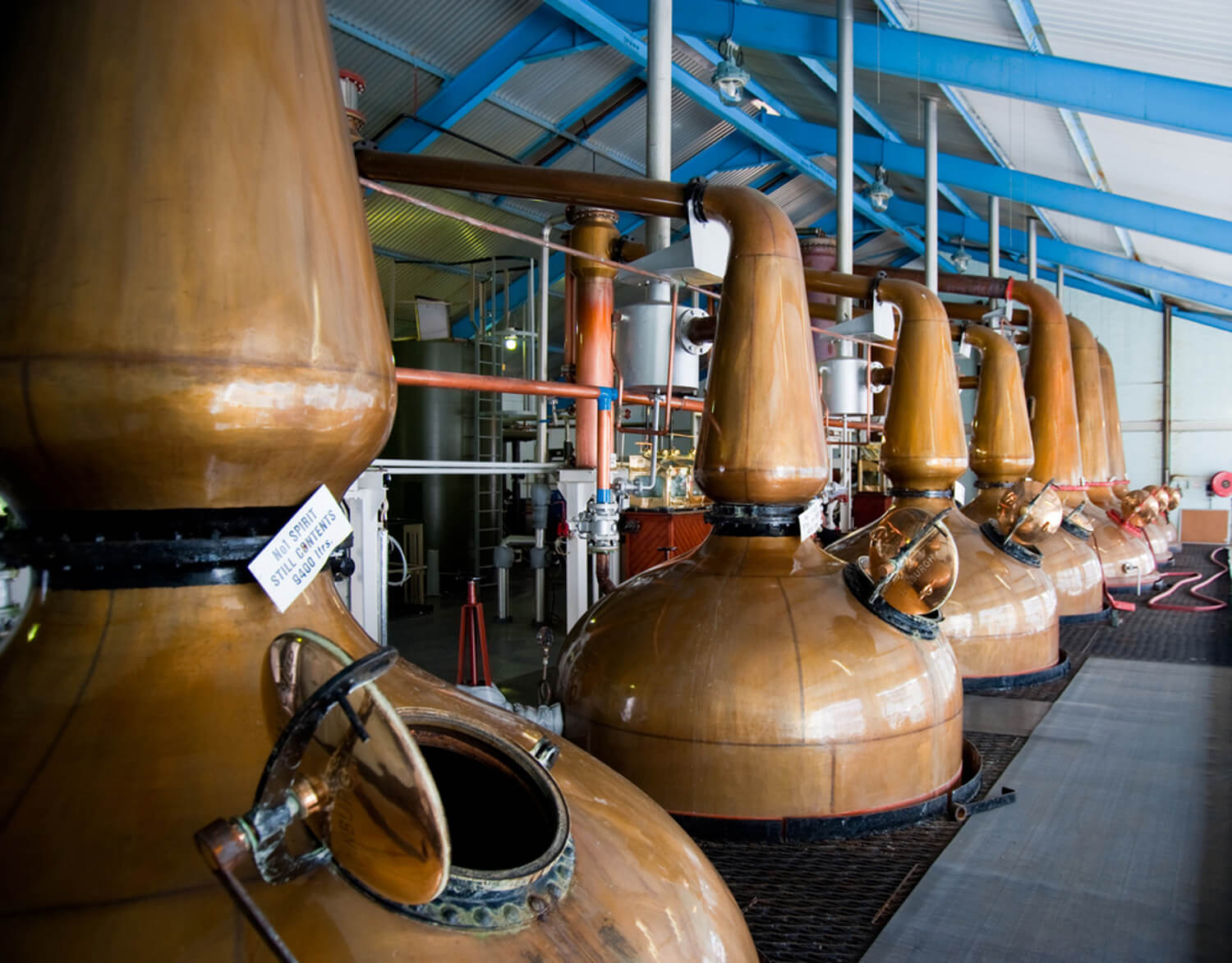March 25, 2018
Liquid Gold
Whisky production includes a number of processes that take place in potentially explosive atmospheres. Learn more about the Pepperl+Fuchs products used in a renowned Scottish whisky distillery.

The Modern Whisky Distillery
The raw beauty of the highlands, with their legendary lochs and castles, Edinburgh's picturesque Old Town, and the unique tradition of bagpipes and kilts—these are the things that make Scotland. Yet for experts and connoisseurs, Scotland immediately brings to mind the world-famous single malt. The north of the small country is home to the world's most famous whisky distilleries. The famous Scotch whisky is created in the valleys where the mist mingles with the salty sea air and the aromatic vapors of malted barley. This fine spirit has been produced in Scotland for centuries. It takes years or even decades for the whisky to mature in large oak casks and develop its unmistakable flavor.
Scotland is the largest whisky producer in the world. Many of the world-famous distilleries still running today were founded way back in the 18th century. Some of them have since developed into large corporations that dominate production of the well-known whisky brands and have long since transferred to modern plants. To produce enormous volumes while also meeting stringent requirements in terms of diversification or specialization in high-quality whiskies requires a complex and reliable process. For maturation, this exclusive drink is stored in wooden casks to fully develop its spicy, smoky, floral, or fruity flavors. First, however, the selected ingredients need to be processed accurately and reliably.
The basic ingredients of each whisky—grain, water, and yeast—are malted, crushed, mashed, fermented, and distilled. The production chain includes a number of processes that take place in potentially explosive atmospheres. 'Dust and gases leaking out of the mills, mash tuns, and stills can create explosive atmospheres inside the buildings. As a result, these areas are predominantly classified as Zone 2,' says Steve Dickinson, Technical Sales Support Manager at Pepperl+Fuchs GB Ltd. 'For this reason, there are specific provisions for ignition protection in these plants,' he adds. This means that the distilleries' automation systems must also meet the current regulations for explosion-hazardous areas. In addition to its measurement technology, an internationally renowned Scottish whisky producer recently updated its control panels and signal transmission systems. As a result, the field devices and valves used at the distillery can now be monitored precisely and the accuracy of the signal transmission is also guaranteed.

Digital Precision
Precise measurement and data transfer are crucial to ensure a consistently high quality of raw material processing. Depending on the distillery size and the number of units, the distillation process alone may require up to 200 control valves. When redirecting control commands to the valves, the whisky producer relies on the LB remote I/O system from Pepperl+Fuchs certified for zone 2. This system connects sensors and actuators to the control panel via PROFIBUS DP. 'The remote I/O system is a modular system that modifies signals between field devices in explosion-hazardous areas and the control panels or control system,' explains Dickinson. The benefits of traditional technology are perfectly combined with those of advanced technologies through remote I/O. 'This setup played a significant role in the modernization of the traditional distillery since all of the existing fieldbus technology is retained, and the remote I/O system is connected with the bus technology of the new control system,' adds Sandy Glidden, Area Sales Manager at Pepperl+Fuchs GB Ltd. The LB system for Zone 2 impresses through its use of intrinsically safe and non-intrinsically safe circuits, as well as a combination of different types of explosion protection.
Safe Monitoring and Control of Field Devices
PROFIBUS PA is used in the whisky distillery for all measuring field devices, including those that measure fill level, pressure, flow, and temperature. The precise digital transmission of PROFIBUS PA with FieldConnex fieldbus technology also meets requirements relating to accurate measurement and signal transmission.
'Housed in the control room, FieldConnex PROFIBUS Power Hubs supply the segment protectors in the field,' Andreas Hennecke, Product Marketing Manager for fieldbus systems at Pepperl+Fuchs says. He explains: 'This reduces wiring costs while simplifying access to diagnostic information.' The configuration takes place using GSD files, so all measurements are shown in the control room with digital precision.
Via PROFIBUS PA, remote configuration, alarms, and diagnostic data from field devices are transmitted to the maintenance system, making it possible to check the plant performance at any time. 'In order to prevent a flood of information or alarms, the data is filtered,' says Dickinson. The plant operator at the whisky distillery receives only the measured values including a general alarm in case of a malfunction, while maintenance technicians and personnel have full access to all other data. 'This allows everyone to keep the plant's processes functional and at a high performance level,' explains Glidden.
Two Technologies, Cleverly Combined
PROFIBUS Power Hubs in the control room connect and supply field devices via PROFIBUS PA. Prior to the use of remote I/O in a stainless steel housing, the valves were operated using PLC cards with point-to-point wiring.
'Since using the LB system in Zone 2, the whisky producer's wiring and installation work has been significantly reduced, meaning that the control panel occupies less space,' explains Hennecke. Integrated LEDs provide an immediate overview of each channel and simplify maintenance.
Due to effective technical support from Pepperl+Fuchs, the commissioning and installation processes were easy to complete, thus saving time and resources. 'In addition, the owners of the Scottish distillery value the ability to have remote access to the configuration and diagnostic data of the measurement technology,' says Dickinson. 'For the senior process engineers at the whisky distillery, the use of PROFIBUS DP, PROFIBUS PA and the digital infrastructure from Pepperl+Fuchs has proven to be very cost-effective. It has minimized maintenance and repairs while also meeting the high demands at production level,' adds Glidden.

Quality, purity and origin of the spring water used are crucial for quality whisky production.
- Preparation: Most of the grain is malted, while corn is typically cooked
- Crushing and mashing the barley
- Fermentation: By adding yeast, sugars begin to ferment until it turns into alcohol.
- Pot still method: The mash is distilled in copper stills during two to three distillation rounds
- Bottling and storage
Whisky is considered a national drink in Scotland. An average of 34 bottles of whisky are exported from Scotland per second.
Half of the Scottish distilleries are concentrated along the famous ‘Malt Whisky Trail’ in the region of Speyside, which is located between the mystical lake Loch Ness and the city of Aberdeen.
Currently the most expensive whisky in the world is the Macallan M. In 2014, this single malt whisky sold at auction for a steep price of 467.000 €.
According to legend, the Celts were the first to distill a clear liquid. The etymology word ‘whisky’ comes from the Scottish/Gaelic, where ‘uisge beatha’ means ‘water of life’.
Whisky is often aged much longer than that. The stillman must look ahead and gauge market demand five, ten or 15 years into the future.
Whisky is drunk at room temperature out of tulip-shaped nosing glasses, allowing the full diversity of aromas to unfold.




